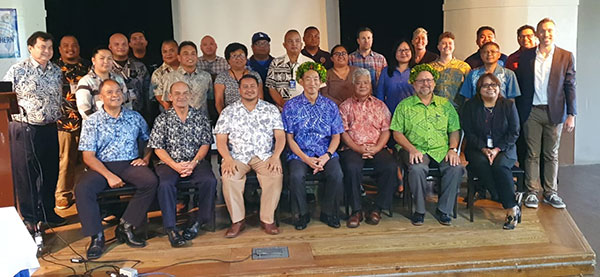CNMI creates emergency medical team

Participants of the CNMI’s Emergency Medical Team pose with CNMI legislators, Gov. Ralph DLG Torres, Lt. Gov. Arnold Palacios, World Health Organization officials, and Team Rubicon officials during the EMT’s formation last Friday at the Pacific Islands Club.
(MARC A. VENUS)
The Commonwealth Healthcare Corp., with the help of the World Health Organization, has created the CNMI’s first-ever Emergency Medical Team, which will be composed of individuals from the different departments of the CHCC and Department of Fire and Emergency Medical Services.
The EMT will be undergoing training sessions this entire week with WHO and Team Rubicon, a disaster response non-government organization from off-island that is composed of military veterans.
This comes as the CNMI welcomed to the CNMI last Friday at the Pacific Islands Club Saipan WHO Western Pacific Office regional director Dr. Takeshi Kasai and his team consisting of Sean Casey and Emma Kettle, and Team Rubicon’s Dennis Clancy.
“The launch of the CNMI’s EMT is a crucial step in the preparedness efforts,” said CHCC CEO Esther Muña, “and allows us to move forward into the potential to expand and use the EMT to help other jurisdictions as we were helped after Typhoon Yutu.”
She said the group’s creation also recognizes that the CNMI needs to improve and expand its response capabilities so that the Commonwealth has the capacity to respond to a full range of emergencies that may have an impact on the health of the community.
Gov. Ralph DLG Torres thanked Muña and her team for collaborating with WHO, saying an EMT for the CNMI will play a crucial role when disasters hit the CNMI and nearby areas. “This is crucial for our safety,” Torres said.
Kasai said the CNMI EMT is the first EMT created in a U.S.-affiliated territory within the Pacific jurisdiction. “The establishment of the EMT is a testament of the leadership of the governor and the CEO,” Kasai said.
Not only will this EMT be an asset for the CNMI, but it will serve as an additional asset for the Pacific. This initial step will help the CNMI respond to disasters quicker and more efficiently, Kasai also commended the CNMI’s response after Super Typhoon Yutu, saying it was delivered in an excellent manner.
According to WHO’s website, EMTs are groups of health professionals that treat patients affected by an emergency or disaster. These teams are formed from governments, charities, militaries, and international organizations such as the International Red Cross/Red Crescent movements.
EMTs work to comply with the classification and minimum standards set by WHO and its partners, and come trained and self-sufficient to not burden the national system.
In his presentation on Friday, Casey stated that the CNMI’s EMT is slated to become a Type 1 team, which deals with outpatient cases. This team only operates in daylight hours and is completely self-sufficient, can be fixed on a certain location or target numerous locations every day.
Type 2 EMTs are district hospitals that deal with inpatient services and surgical services, while Type 3 EMTs are high level hospitals capable of performing surgical services, orthopedic specialties, intensive care, and any other services needed.



























